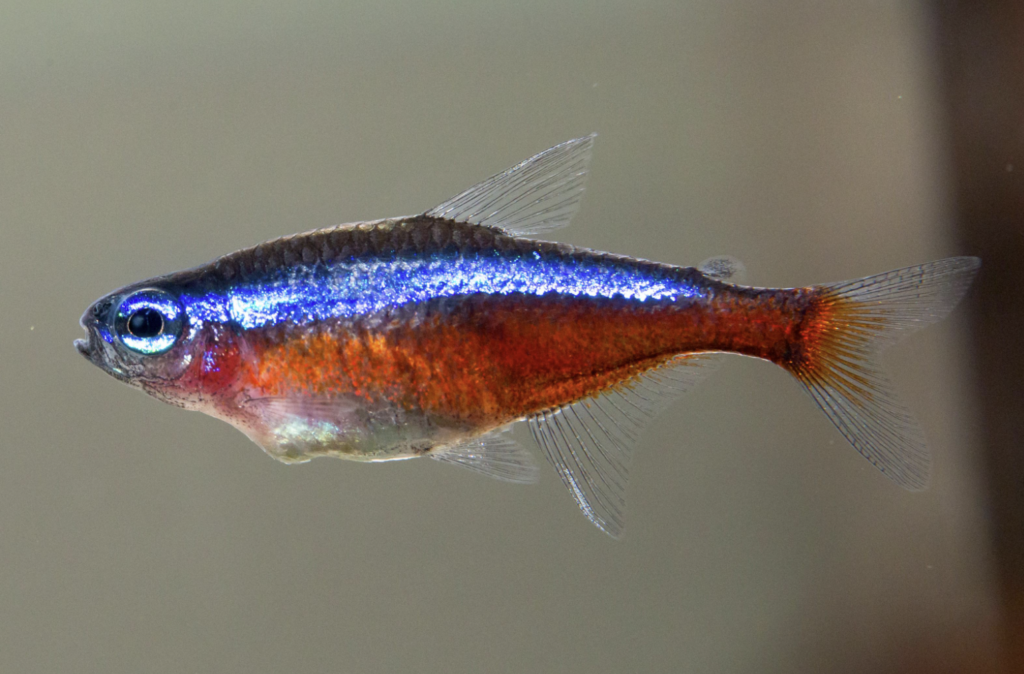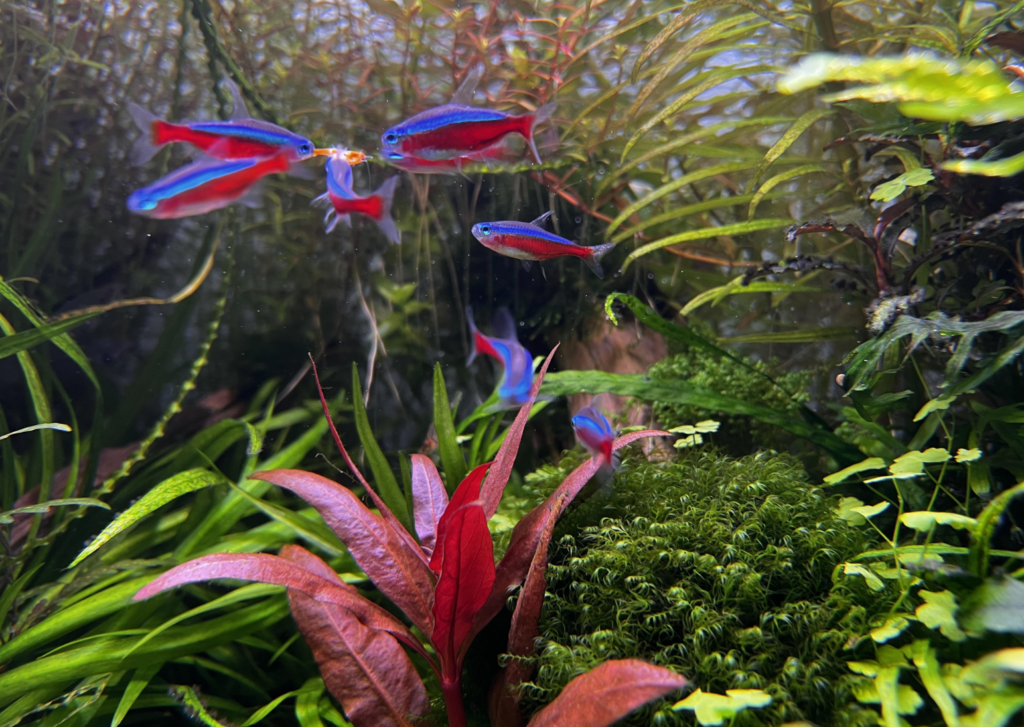Cardinal Tetras (Paracheirodon axelrodi) are often regarded as one of the most loved and prominent fish within the circle of aquarium hobbyists. In this comprehensive guide, we will examine the various aspects of Cardinal Tetra fish, from their characteristics and origin to their care, feeding habits, breeding and more.

Characteristics
Cardinal tetras are small, streamlined fish with a unique elongated body shape. The Cardinal Tetra exhibits a remarkable visual presentation characterized by a vivid contrast of iridescent blue and fiery red.
Its slim body is outlined with a typical horizontal stripe running from nose to tail. This fascinating feature adds an air of elegance to the fish, making it a prized addition to any aquarium.
| Scientific Name | Paracheirodon axelrodi |
| Common Name | Cardinal Tetras |
| Common health issues | Ich, fin rot, and fungal infections |
| Origin | South America, particularly Amazon Basin |
| Life expectancy | 3-5 years |
| Size | Typically, 1.5inces |
| Color and marking | Vibrant electric blue and fiery red |
| Tank size | Minimum tank capacity of 10 gallons |
| Temperament | Peaceful and Social |
Origin
In addition to the blackwater streams of the Amazon River basin in South America, Cardinal Tetras are found in countries such as Brazil, Colombia, and Peru. They reside in slow-moving streams and flooded forest regions where the water is soft, acidic, and stained brown by tannins produced by decaying organic matter.
In their native environment, Cardinal Tetras form large shoals among dense vegetation, where they seek refuge from predators and forage for food. The Cardinal Tetras’ lifespan is up to 3-5 years.
Size
When fully grown, Cardinal Tetras are approximately 1.5 inches (3.8 cm) in size making them highly suitable for smaller aquarium setups. However, it’s fundamental to provide sufficient space for these energetic swimmers, guaranteeing a stress-free atmosphere that promotes their well-being.
Colors and Markings

Undoubtedly, the most notable characteristics of Cardinal Tetras are their bright colors and markings. The upper half of their bodies are covered with a magnificent neon blue stripe, while the lower half showcases a bold crimson red stripe.
An eye-catching horizontal stripe spans from the nose to the base of their tail, contrasting sharply against the fish’s shining backdrop. This captivating color pattern functions as both a defense mechanism and a visual spectacle, attracting spectators and guarding off potential predators.
Right Aquarium Size
When determining the ideal aquarium size for Cardinal Tetras, their natural behavior and preferences for their surroundings must be considered. Despite their small size, Cardinal Tetras are highly social creatures that flourish in large groups.
Therefore, it’s advisable to house them in a tank that has a minimum capacity of 10 gallons (38 liters) for a small shoal. However, larger tanks, such as 20 gallons (75 liters) or more, are preferable, as they provide ample space for a larger school of Tetras to swim and explore.
Tankmates

Cardinal Tetras are calm and non-aggressive fish that can live pleasantly with a diverse range of tankmates. Nevertheless, it’s imperative to select companions that share similar water parameters and temperaments to guarantee their compatibility.
Cardinal Tetras tank mates include other small, peaceful community fish, such as Corydoras catfish, dwarf cichlids, and small rasboras. Refrain from pairing them with aggressive or larger species that may threaten or prey on them.
Cardinal Tetra Care
Providing adequate care for Cardinal Tetras involves imitating their genuine habitat as closely as possible within the confines of an aquarium.
This includes the maintenance of stable water conditions, including a pH level ranging from 5.0 to 7.0 and a cardinal tetra temperature between 75°F and 82°F (24°C and 28°C). Soft, acidic water is preferred, because it closely mirrors the conditions of their native Amazonian environment.
Provide a well-planted aquarium with plenty of hiding spots and open swimming areas. Dense vegetation, such as Java moss and Amazon sword plants, serves to replicate their native habitat and offers security for the fish. Ensure adequate filtration and gentle water flow to maintain water quality and oxygenation.
Diet and Feeding

Feeding Cardinal Tetras is essential for their health and vitality in an aquarium setting. These omnivorous fish require a balanced diet consisting of both commercial and live foods to thrive. Here’s a guide to ensuring optimal nutrition for Cardinal Tetras:
1. Provide premium quality flakes, pellets, and granules prepared for small tropical fish. These provide the necessary nutrients and vitamins.
2. Supplementing their diet with frozen or freeze-dried foods adds variety and improves nutritious consumption. Cardinal Tetras gives preference to specific treats like bloodworms, brine shrimp, daphnia, and tubifex worms.
These protein-rich options copy their natural diet, supplying vital amino acids and promoting natural feeding behaviors. Offer these foods as occasional treats to prevent overfeeding and to maintain water quality.
3. Feed small amounts, two to three times daily, make sure they finish their meal within a few minutes to avoid overfeeding. Modify the feeding frequency based on the fish’s activity level, temperature, and other environmental factors.
Gender Differences
It might be difficult to differentiate between male and female Cardinal Tetras, as they exhibit minimal sexual dimorphism. Nonetheless, it is observed that female Tetras tend to have a little rounder and fuller belly when viewed from above, particularly during the period of carrying eggs.
Furthermore, during the breeding season, females may appear slightly larger and more robust than males. Despite these subtle differences, the most effective method for determining the sex of Cardinal Tetras is by monitoring their behavior during spawning activities.
Breeding

Cardinal tetras breeding in your home aquarium can be a satisfying but challenging venture. To encourage spawning, provide them with optimal water conditions, including soft, acidic water with a slightly elevated temperature.
Additionally, simulate the onset of the rainy season by performing large water changes and lowering the water level in the tank. Provide ample vegetation or spawning mops for the tetras to deposit their eggs, and remove the adults promptly after spawning to prevent them from consuming the eggs.
Breeding successfully is possible through determination and effort, allowing you to view the fascinating life cycle of these charismatic fish.
Conclusion
Cardinal tetras are a captivating species that bring color and vibrancy to any aquarium. With their striking appearance, peaceful demeanor, and relatively low maintenance requirements, they are an ideal choice for aquarists of all skill levels.
By understanding their characteristics, origin, care needs, and breeding behaviors, you can create a thriving environment for these beautiful fish and enjoy their beauty for years to come.










